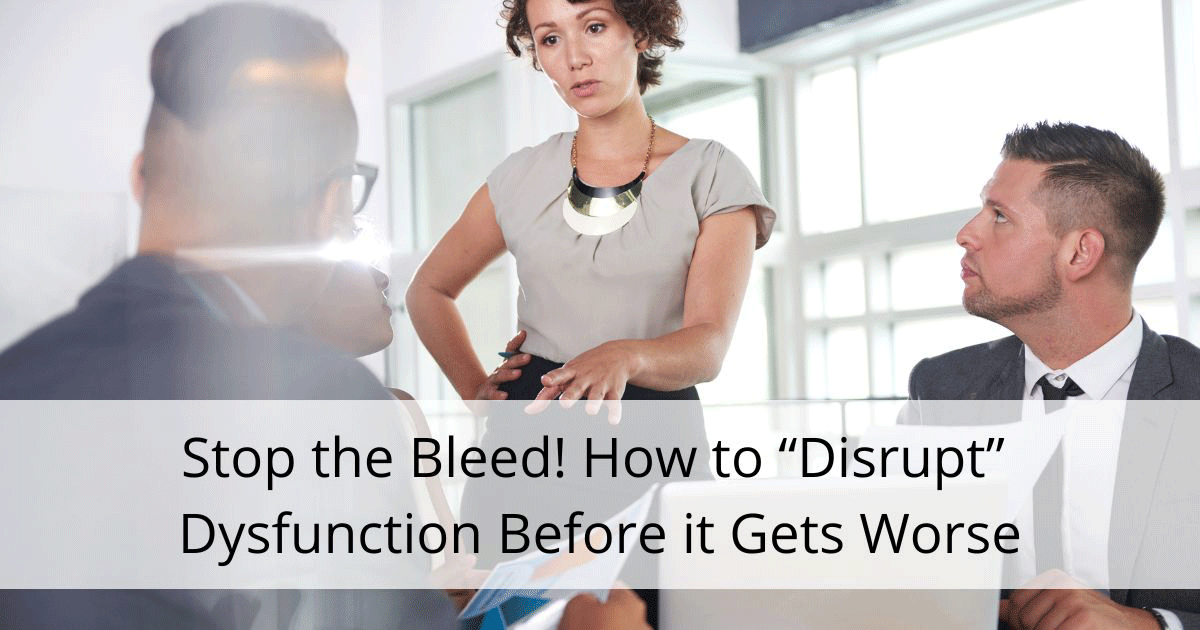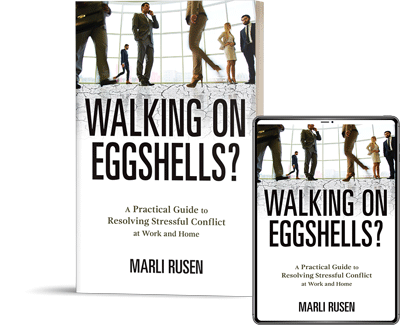Resources > Blog > Stop the Bleed! How to “Disrupt” Dysfunction Before it Gets Worse

Lately, I am seeing a number of articles and posts saying things like “How to Stop Getting Anxious at Meetings” or “Why you Shouldn’t be Angry at Work” or “How to Become Less Defensive”.
To me, this is akin to suggesting “How Not to Breathe”, “How to Stop that Sneeze” or “How Not to Get Goosebumps”.
Physiological and emotional reactions and feelings in response to our always changing external circumstances are going to happen. No amount of therapy, yoga or meditation is going to stop them, nor should they be stopped. Many times, our triggers (anger, fear, embarrassment, anxiety and otherwise) are signs that we are not “okay with” or comfortable in a particular situation. Similarly, our defensiveness may be signaling that we need to defend ourselves against a personal or professional attack.
Whatever the situation may be, someone is saying or doing something that is causing our body to send us a “stress signal”.
That is all we truly know in the moment.
The stress signal does not necessarily mean they are doing something wrong nor does it mean that we are being overly sensitive.
We don’t need to figure any of this out, at least initially.
The first step towards constructive conflict resolution is to stop the dysfunction/discomfort as soon as reasonably possible and then figure out “next steps” after we have regrouped, recharged and reflected on what took place.
The entire first chapter of my latest book “Walking on Eggshells?” is committed to this important process. The first conversation in any conflict has to be with ourselves once we feel safe enough to do so.
Identifying our Triggers
It is important to pay attention to how your body responds when it believes it is under threat – from disrespect, a violation of boundaries, perceived inequity/discrimination or otherwise. Some people get physically hot; others’ heart rates increase; some people find their stomachs “drop” or go into knots, the list goes on.
Knowing how our body reacts helps us identify when we are triggered so that we can take healthy action before taking unhealthy action – that is, by saying or doing something that we will later regret.
Responding once Triggered
Often, people mistakenly think that they have to learn “what to say” when triggered. Many clients have joked that they need a “Marli app” on their phone which will give them the right words to say to resolve a given situation right then and there.
Here’s the thing – there’s no such thing. The answer lies in saying less – not more – in the heat of the moment so that you give yourself time to figure out what to say when things have cooled off later on.
Say enough to disrupt the dysfunction; and then disengage from the situation as soon as possible.
For example, imagine you are in a meeting and someone is speaking to you – or to your colleague – in a very condescending or aggressive manner; or is making wholly inappropriate and discriminatory comments about anything from appearance to life choices to educational level to gender to place of origin. Perhaps they are engaged in visibly inappropriate and targeted non-verbal behavior, such as snickering, eye-rolling, smirking and otherwise.
What is most critical – at this stage – is to get it to stop.
As many of us know, this is not as easy as it sounds. The person behaving in this way (a customer, patient, colleague, stakeholder or leader) may be known to be quite aggressive and unpredictable; the person may have organizational or societal power over you or others (or may be connected to those who do); or you may not be someone who is comfortable speaking up for fear of rocking the boat. This may be related to your personality, history, age, gender, cultural background, seniority, lack of power or other reasons.
When situations like this arise, consider one of the following options as a possible first step. Your preference will depend on your comfort level and the specific circumstances you face. There is no one right way to respond:
- Disrupt the dynamic by changing the topic – ask an unrelated question or raise a different point. No one needs to know your underlying rationale for doing so.
- If the commentary is coming your way, excuse yourself – go to the washroom, or leave to answer an “urgent call”. If the dysfunction is directed at someone else, perhaps tell them that you need to speak to them in private.
- The main goal – at this time – is to get it to stop. Make something up to shake things up.
- Some people – when faced with this situation – might be comfortable with disrupting the dynamic by discussing what they are seeing or hearing and directing that it stop. This is not the time to engage in a debate about “right or wrong” or cast aspersions on the other person’s intentions, values or agenda – it is simply the time to say “I am not comfortable with x and y and ask that it stop. Let’s focus on the next item on the agenda.” More fulsome discussions about this can and should happen at a later time, outside this event.
- If any of these strategies do not result in the behavior ending, then it’s time to discontinue and depart. End the discussion or meeting – or at the very least, end your participation in it.
- No one is expected to remain captive to a persistently disrespectful and possibly unsafe situation. No one should be expected to allow others to walk all over them. No client is big enough, no leader is powerful enough, no coworker is passionate enough to expect others to be their mat or punching bag.
- That said, no one should stay in the situation and engage in a counter-attack, by speaking or acting in a similarly disrespectful or disruptive manner. No one has the right to convert the workplace into a boxing ring, even if they think that someone else “punched first”.
- The goal is simply to identify our triggers and then engage in respectful disruption, disengagement and/or discussions to mitigate harm from the immediate dysfunction as soon as reasonably possible.
Now What?
- Once you have removed yourself from the situation, or the dynamic has otherwise ended, take time to rest and then reflect on what happened.
- Don’t make any decisions as to next steps. Don’t gossip. Don’t post on social media. Don’t “posse build”.
- Do Nothing. Go home. Eat something delicious. Sleep.
- At this point, you are now at the stage that many conflict resolution consultants and policies refer to as your “first step”. Far from it! By taking the many steps above – understanding your triggers, recognizing them as soon as they appear, and responding in a constructive manner, you already have done wonders to minimize the harm to yourself and to your long-term relationships with others in the workplace (or at home).
- After you have removed yourself, regrouped, recharged and reflected, you are in a much better position to more clearly understand what bothered you so that you may determine the best next steps. Perhaps you will approach the person directly; or perhaps you’ll speak to a supervisor, union rep or human resources about what happened. You may decide not to do anything yet. There are many resources out there (including my Guide!) that can assist you in making this decision.
- The goal of this article is to remind you that you ARE going to get triggered. That is not a sign of weakness – it is simply a sign that you are a living human.
- Further, getting triggered is often an important signal that something needs to change in your environment – at least in that moment, and possibly beyond.
- Don’t make it your goal to “not feel” or “not become triggered”. Don’t try to rid yourself of anger, frustration, or embarrassment. Instead, learn how to spot (in yourself) when this happens so that you can respond in a way that makes the situation healthier and more respectful for all involved.
Sign up for our newsletter mailing list and receive a digital copy of the first chapter of my popular Guide, “Walking On Eggshells? A Practical Guide to Resolving Stressful Conflict At Work and Home”.

